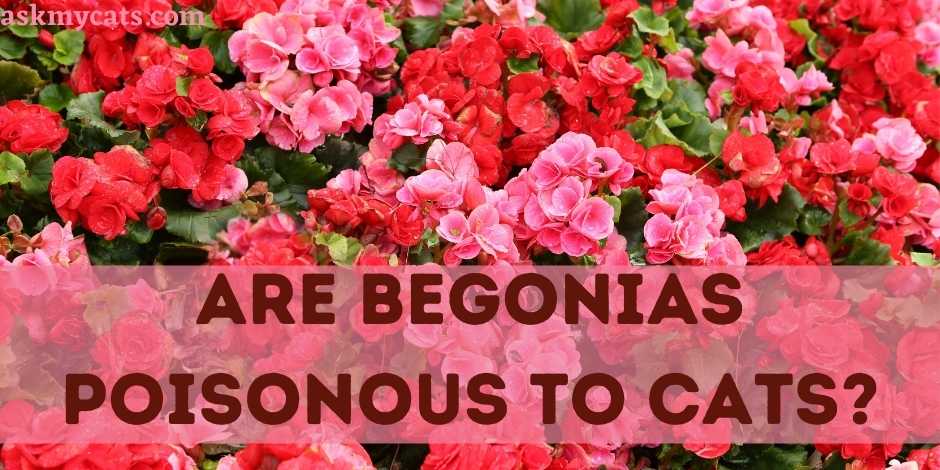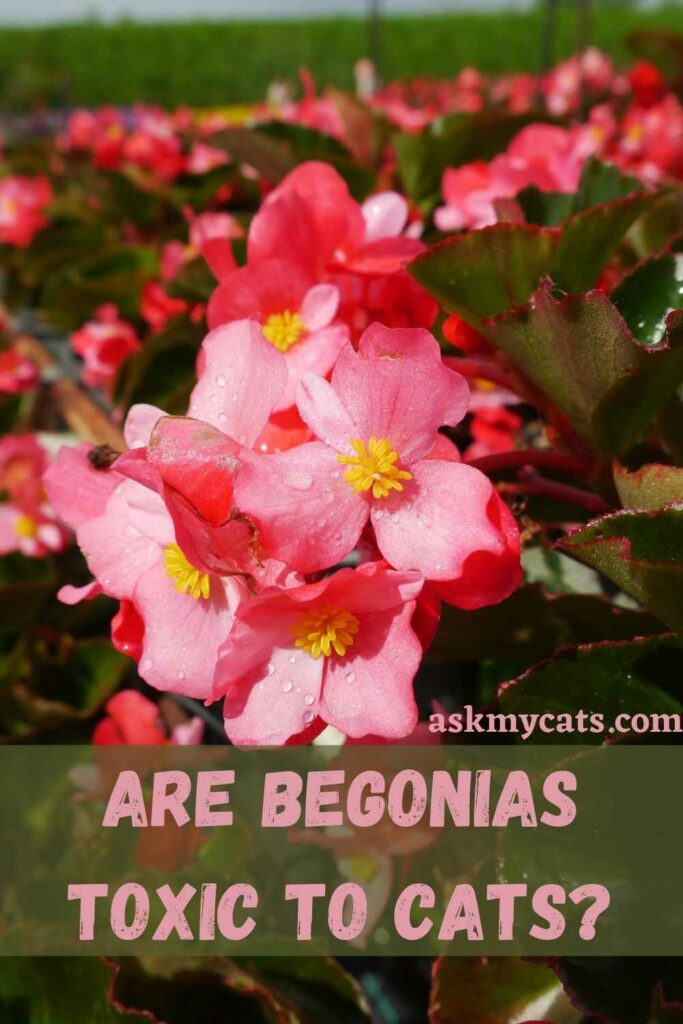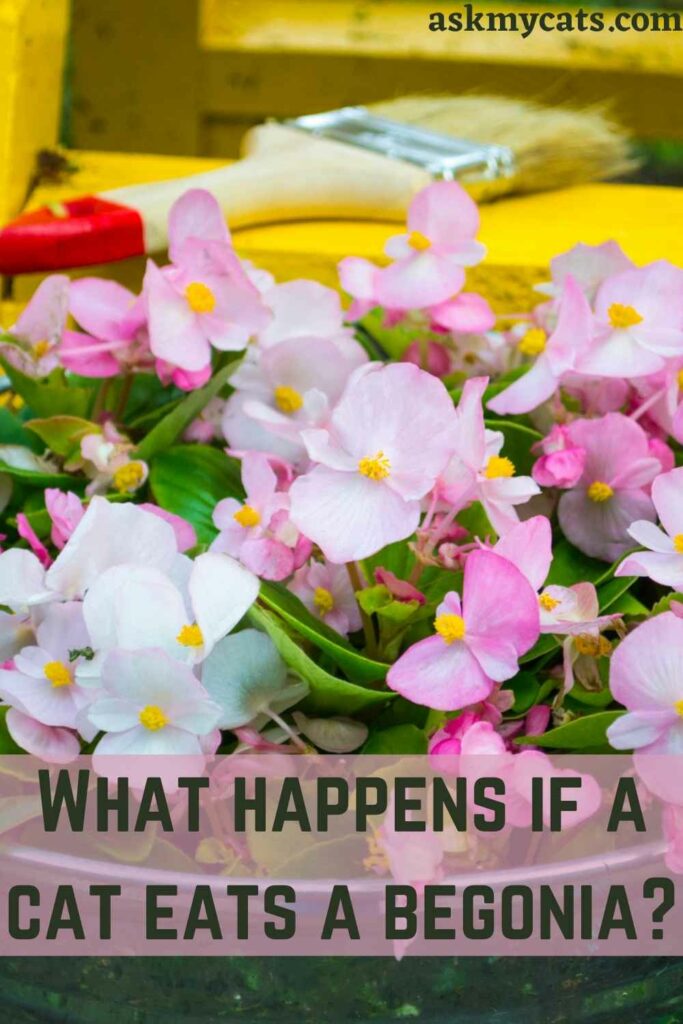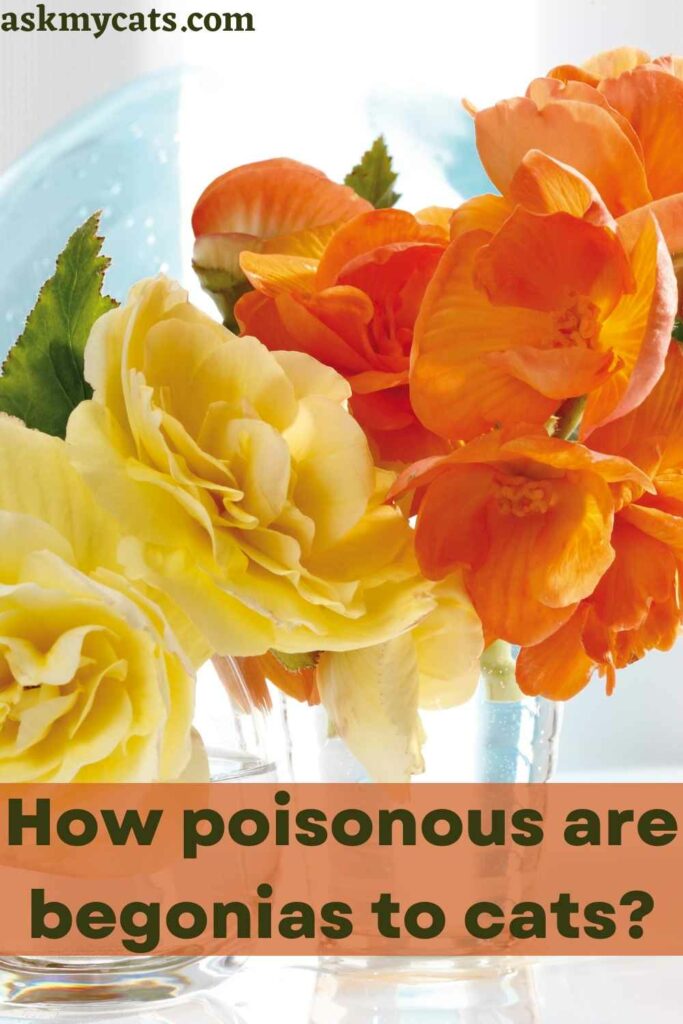Begonia is the genus name for over 1800 perennial flowering plant species that are native to tropical and subtropical moist climates and belong to the family Begoniaceae.
They make excellent indoor houseplants in colder climates, or you can cultivate them during the summer. They can have maroon, bronze, or green leaves, as well as very attractive white, rose, yellow, pink, or scarlet flowers, depending on the species and variety.
However, are begonias poisonous to cats?
Yes, begonias are poisonous to cats. Many begonia species are toxic to cats, despite their beauty. Unfortunately, they contain soluble calcium oxalates, which can be harmful to your cat’s health if swallowed. Cats and other small mammals are particularly vulnerable to the effects, as even a small amount of begonia can cause significant damage and discomfort.
This article will talk about why you should keep your cat away from begonias and the risks they pose.


Give Your Cat the Perfect Day
Get the Free Ebook!
Do Cats Like Begonias?
It is entirely dependent on the cat and its personality whether or not it likes begonia.
Although it is clear that begonia is toxic to cats, the answer to the question of whether cats like begonia or not is less clear.
Begonias aren’t among the most popular foods that cats dislike or prefer.
This can be discovered by placing a begonia plant near your cat in your home or yard. Examine your cat to see if it is purring and walking around near the plant. Your cat likes begonia if you said yes.
Are Begonias Toxic To Cats?
Yes, begonias are toxic to cats.

Many begonia species are toxic to cats, despite their beauty. They are popular garden and houseplants, with over 1,000 species and even more hybrids.
They thrive outside, but they can’t survive temperatures below 50 degrees Fahrenheit, so many people bring them inside during the winter.
Unfortunately, they contain soluble calcium oxalates, which can be harmful to your cat’s health if swallowed.
Identification can be difficult with so many different begonia species. However, there are some characteristics that you can look for to help you identify your plant.
If you’re still unsure, your local nursery will most likely be able to help you identify the plants.
The plants reach a height of 1 to 1 1/2 feet and have smooth, waxy leaves up to six inches long. Leaves can be green, silver, yellow, white, purple, or variegated depending on the species and cultivar.
Begonias have pink, red, white, or yellow flowers that bloom in the summer and fall. Bicolor blooms can be found on some plants.
Begonias are a common flowering plant with large, colorful flowers that are commonly used in flowerbeds and larger pots.
Gardeners should be aware, however, that despite its attractive appearance, the begonia can be poisonous if eaten. Due to the small amount of begonia that must be eaten to cause damage and discomfort, cats and other small mammals are especially vulnerable to the effects.
Begonias are poisonous to cats, despite their attractiveness and allure. Cats, dogs, and horses are poisoned by all species and hybrids of begonias, including Rieger begonias, Begonia Tiger Kitten, Strawberry Begonia, Begonia maculata, and wax begonias.
Ingesting begonias causes an intense burning sensation in the mouth, which can cause irritation of the throat and stomach in cats and many small mammals, including dogs.
Vomiting, excessive salivation, and swelling of the lips and tongue are all possible side effects. Depending on how much of the plant the animal consumes, the degree of irritation varies from mild to severe. In severe cases, cats and other animals may be unable to eat. Complications may arise due to the cat’s age and overall health status.
What Happens If A Cat Eats A Begonia?
If a cat eats begonia, it can show symptoms like vomiting, excessive salivation, and throat irritation.

Though begonia poisoning is rarely fatal, it can cause a number of noticeable symptoms.
Owners who notice these symptoms should immediately take their cat to the veterinarian to avoid further complications.
- Excessive salivation
- Oral sores
- Redness around the mouth
- Swelling of the mouth and tongue
- Licking the lips and grimacing
- Vomiting
- Dehydration
- Inability to swallow
- Refusal of food and water
The begonia plant contains a substance called oxalate in large amounts.
The oxalate crystals embed themselves in various tissues, causing irritation, and can break down into ‘oxalic acid,’ which is also a potent irritant, once ingested.
By vomiting and attempting to dilute the acid with saliva, the cat’s body will try to avoid further irritation and damage to the digestive tract.
A small amount of the toxin will eventually enter the bloodstream and travel to the liver. This turn of events is especially dangerous because oxalic acid, in large enough doses, can cause catastrophic liver failure, resulting in serious illness and even death.
Additionally, cats are poisoned by all parts of begonias, with the tubers being the most toxic. Because they contain soluble oxalates, they are harmful or dangerous.
For starters, the oxalate can be broken down to oxalic acid when it embeds itself in various tissues, causing irritation. When oxalic acid is absorbed into the body, it promotes the formation of urinal and bladder crystals (struvite and calcium oxalates uroliths), which can cause kidney damage.
How Poisonous Are Begonias To Cats?
Begonias are very poisonous to cats if eaten in large quantities and can even result in death if not treated quickly.

If cats eat Begonia, they will experience severe mouth burning and irritation.
Ingestion can also cause excessive drooling, vomiting, and difficulty swallowing in your pet. Vomiting, hypersalivation, and diarrhea are all symptoms of eating it.
A substance called oxalate is found in abundance in the begonia plant.
Once ingested, the oxalate crystals embed themselves in various tissues, causing irritation, and they can break down into ‘oxalic acid,’ which is also a strong irritant.
The cat’s body will try to avoid further irritation and damage to the digestive tract by vomiting and diluting the acid with saliva.
A small amount of toxin will enter the bloodstream and make its way to the liver.
This is especially dangerous because oxalic acid, in high enough doses, can cause catastrophic liver failure, leading to serious illness and even death.
The American Society for the Prevention of Cruelty to Animals (ASPCA) considers begonias to be poisonous to cats. The toxicity of this plant is due to the presence of insoluble oxalates.
Oxalic acid, one of the strongest organic acids found in plants and fungi, is used to make insoluble oxalates. Tubers are the most toxic to cats, according to the ASPCA.
Cats will have negative health effects if they eat the begonia plant or flower. Vomiting, excessive drooling, difficulty swallowing, mouth burning, and irritation of the tongue, mouth, and lips are the most common symptoms of begonia ingestion. The most toxic plants in the Begoniaceae family are tuberous begonias.
What Part Of Begonia Is Poisonous To Cats?
Tuberous roots underground are the most poisonous part of begonia to cats.
The tuberous roots underground are the most toxic part of the begonia. If your cat enjoys digging in your houseplants, or if he knocks the pot over and begins snacking on the plant, he may get into the roots.
Begonias are classified as having a low poison severity by North Carolina State University Cooperative Extension, but that doesn’t mean they won’t cause problems for your cat.
Vomiting and excessive salivation are the most common symptoms of begonia poisoning. Kidney failure can occur in grazing animals, but this isn’t usually a problem for cats.
Unlike some other poisonous plants for dogs and cats, touching the leaves or flowers of begonias does not cause contact dermatitis.
Ingesting begonias causes an intense burning sensation in the mouth, which can cause irritation of the throat and stomach in cats and many small mammals, including dogs.
Vomiting, excessive salivation, and swelling of the lips and tongue are all possible side effects. Depending on how much of the plant the animal consumes, the degree of irritation varies from mild to severe.
In severe cases, cats and other animals may be unable to eat. Complications may arise due to the animal’s age and overall health status.
Most cases of begonia poisoning are mild, and they go away on their own in about 48 hours. The vet may recommend a liquid-only diet, which is easier on the stomach and helps dislodge any oxalate crystals that remain lodged in the digestive system.
Anti-inflammatories will be required to reduce throat swelling and maintain a clear airway. In order to increase the viscosity of the stomach contents and thus protect the stomach lining, additional drugs may be required. Fluid therapy may be required depending on whether or not dehydration has set in.
The total recovery time for a severe case of begonia poisoning is surprisingly short, with most cases being resolved in two weeks or less, with no need for follow-up appointments.
The reason for this is that oxalate crystals lose their potency quickly, meaning that if you don’t eat more, your body’s oxalic acid levels will quickly decline.
This is good news for cats and their owners because it means that exercise and normal feeding will be restricted for a shorter period of time.
However, if the esophagus has been severely damaged, the veterinarian may decide to temporarily insert a feeding tube (most likely in the form of a nasal catheter).
This will prevent the cat from stressing damaged tissues in the digestive tract by swallowing, instead of allowing them to heal on a liquid diet.
Are Begonias Leaves Poisonous To Cats?
Yes, begonias leaves are poisonous to cats.
Cats are poisoned by all of the over 1000 species of begonia. Your cat’s mouth will most likely burn after eating begonia leaves, and vomiting may occur.
The plant’s juices and sap contain poisonous needle-shaped crystals that are microscopic. The plant is mildly toxic, but the roots are particularly dangerous. In any case, it’s a good idea to contact a veterinarian.
If your cat eats begonia leaves or shows signs of poisoning, seek medical attention right away. Check your cat’s breathing while he’s away from the begonias.
If your cat is having trouble breathing, it is a medical emergency, and you should take him to the veterinarian right away.
Take a sample of the plant your cat ate to confirm the species and type of poisoning he or she is likely suffering from.
Are Tuberous Begonias Poisonous To Cats?
Tuberous begonias are the most poisonous part of the plant to cats.
In cooler climates, begonias are commonly grown as ornamental houseplants. With over 1,800 different plant species in the family Begoniaceae, this genus is one of the largest of flowering plants. Some species are grown outdoors in the summer for their brightly colored flowers. Some people consume them, which has a sour flavor.
Begonias are poisonous to cats, despite their attractiveness and allure. Cats are poisoned by all species and hybrids of begonias, including Rieger begonias, Begonia Tiger Kitten, Strawberry Begonia, Begonia maculata, and wax begonias.
Additionally, cats are poisoned by all parts of begonias, with the tubers being the most toxic. They are harmful or dangerous because they contain soluble oxalates, which can cause the following symptoms when consumed:
- Drooling or salvation
- Vomiting
- Kindy damage (commonly noted in horses or grazing animals)
- Reduce appetite
- Difficulties in swallowing
- Swollen mouth and tongue
- Redness around their mouth and lips
For starters, the oxalate can be broken down to oxalic acid when it embeds itself in various tissues, causing irritation. When oxalic acid is absorbed into the body, it promotes the formation of urinal and bladder crystals (struvite and calcium oxalates uroliths), which can cause kidney damage.
Are Angel Wing Begonias Poisonous To Cats?
Yes, angel wing begonias are poisonous to cats.
The Begoniaceae family includes the Angel Wing Begonia plant, which was first discovered in the tropical and subtropical regions of South America.
Many of the plants in this family have brightly colored flowers or intricately patterned leaves and can be used as houseplants, potted outdoor plants, or garden plants. The cane begonia group includes a large number of angel wing begonias.
Angel Leaf Begonia, Spotted Begonia, Spotted Angel Wing Begonia, Angel Begonia, and Dragon Wing Begonia are some of the names given to this unusual plant.
The plant is a hybrid of the begonia aconitifolia and begonia coccinea begonias. Long stems with “joints” on them are found on all cane begonia plants; the leaves and flowers grow from these joints.
An angel wing begonia plant is slightly poisonous to cats. If cats eat the Begonia plant, they will experience severe mouth burning and irritation. Ingestion can also cause excessive drooling, vomiting, and difficulty swallowing in your pet.
Angel wing begonias are a plant that is extremely toxic to our cats. The Begonia, if consumed, can cause significant throat and mouth irritation. This plant can also cause your cat to vomit, drool, and have difficulty swallowing.
Are Rex Begonias Poisonous To Cats?
Yes, as per ASPCA rex begonias are poisonous to cats.
Rex begonias are subtropical and tropical moist climate terrestrial herbs or undershrubs that grow in South and Central America, Africa, and southern Asia. They are popular in homes and gardens because of their brightly colored flowers and large, variously marked leaves.
Begonia rex is the scientific name for this plant. King Begonia, Painted Begonia, Painted Leaf Begonia, Peace Begonia, and Begonia are some of the other names for this plant.
Both cats and dogs are poisoned by the Rex Begonia. Inability to swallow, kidney failure, salivation, sores, and vomiting are all common symptoms.
This is not only inconvenient and unpleasant for your cat, but it is also potentially dangerous.
If you have a cat, you can avoid this problem by keeping your plant out of the reach of the cat as long as they can’t get to it. If you have a cat, you might want to reconsider getting this plant because cats are excellent climbers and can get into even the most difficult-to-reach places despite your best efforts.
Are Strawberry Begonias Poisonous To Cats?
Yes, strawberry begonias are poisonous to cats.
Toxic to pets are all of the over 1000 species of begonia. Your cat’s mouth will most likely burn after eating strawberry begonias, and vomiting may occur.
The plant’s juices and sap contain poisonous needle-shaped crystals that are microscopic. The plant is mildly toxic, but the roots are particularly dangerous.
Strawberry begonias flowers bloom in the spring in a wide range of climates, but their stems – particularly the part that is rooted underground – can be toxic to dogs and cats if eaten.
Strawberry begonias can cause severe mouth burning, swollen tongues and lips, and even difficulty swallowing if consumed.
Are Dragon Wing Begonias Poisonous To Cats?
Yes, dragon wing begonias are poisonous to cats.
Dragon wing begonia house plants are attractive and easy to care for
In late spring and summer, expect sprays of white, pink, or red flowers. The big, glossy wing-shaped begonia leaves are lovely even when they aren’t in bloom.
Cats will have negative health effects if they eat the dragon wing begonia plant or flower. Vomiting, excessive drooling, difficulty swallowing, mouth burning, and irritation of the tongue, mouth, and lips are the most common symptoms of dragon wing begonia ingestion. The most toxic plants in the Begoniaceae family are tuberous begonias.
Frequently Asked Questions
How to treat begonias poisoning in cats?
If your cat eats a begonia plant or shows signs of poisoning, seek medical attention right away. Check your cat’s breathing while he’s away from the begonias. If your cat is having trouble breathing, it is a medical emergency, and you should take him to the veterinarian right away. To discuss your cat’s symptoms and possible treatments, contact your veterinarian, the Pet Poison Helpline, or the ASPCA Animal Poison Control Center. Before symptoms become severe, treatment is usually easier and less expensive. The most common symptoms include vomiting, excessive drooling, difficulty swallowing, mouth burning, and irritation of the tongue, mouth, and lips.
How to diagnose begonia poisoning in cats?
The vet will usually run a battery of tests to determine the exact nature of the substance the cat has ingested in order to make a complete diagnosis. These tests will usually include a blood test, a physical examination, and, if necessary, an endoscopy to examine the digestive tract in detail. Notifying your veterinarian about the cat’s possible access to the begonia plant can help speed up diagnosis and treatment.
How long does it take for cats to recover from begonia poisoning?
The total recovery time for a severe case of begonia poisoning is surprisingly short, with most cases being resolved in two weeks or less, with no need for follow-up appointments. The reason for this is that oxalate crystals lose their potency quickly, meaning that if you don’t eat more, your body’s oxalic acid levels will quickly decline. However, if the esophagus has been severely damaged, the veterinarian may decide to temporarily insert a feeding tube (most likely in the form of a nasal catheter). This will prevent the cat from stressing damaged tissues in the digestive tract by swallowing, instead of allowing them to heal on a liquid diet.
